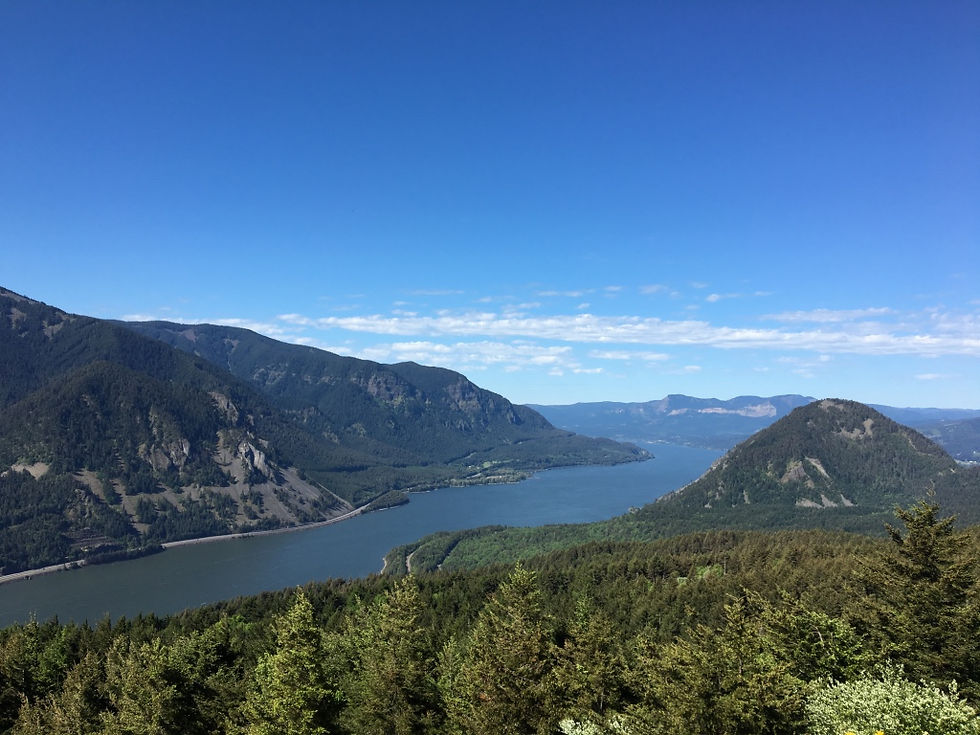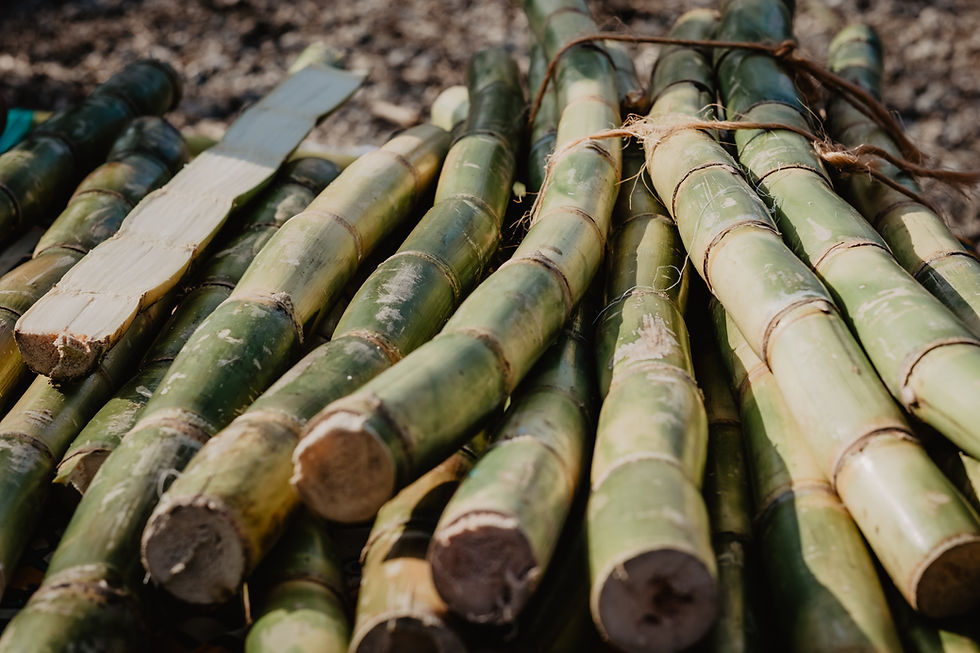To Honour is to Steward: territorial waters of the Pacific Northwest
- Elizabeth Dean
- Sep 22, 2020
- 7 min read
Updated: Oct 22, 2020
“Don’t call us a minority. We come from the land. We are the earth, we are the land. The others occupy the land. When you destroy the salmon, you destroy me.” — Louie Dick Jr. of the Confederated Tribes of the Umatilla Reservation.
Salmon graces the menus of hundreds of Portland restaurants — lovingly poached in butter, pan seared with tarragon, or grilled with a fresh wring of lemon, coaxing consumers with its bright sunset-coloured hue. Reminiscent of the wild waters and streams in which it swam, it is evocative of its mountainous and wooded locale. Portland, Oregon is squarely situated in the Pacific Northwest of the United States, sharing the Columbia River with Washington state. For those culinarily inclined, Oregon is overflowing with natural bounty - and here, Salmon is King.

The most privileged and diligent among the bon viveurs ask the socially important questions – “where was this caught?”, “is this sustainable?” – believing themselves to be active and engaged consumers. To a certain extent they are. But a question many of these conscious consumers miss is why Portlanders have such a connection to this prehistoric beast. As a natural resource, inhabitants of the Pacific Northwest and the Salmon that swim up it’s rivers have a long history that details the region’s ecological ingenuity and colonial violence.
Broadly, there are seven different species of Salmon that spawn in Oregon waters: Chinook, Coho, Sockeye, Pink, and Chum. Record of their existence dates back 15 million years and the current population can be traced to the last glacial period around 17,000 years ago. The main species that grace menus of Portland restaurants are often Chinook, Sockeye and Coho, each precious in terms of gustatory value and proximity to extinction. Chinook is lauded for its natural flavour and texture and at risk of extinction due to dwindling habitat in Washington, Oregon, and California. Coho is sought for its fatty yet tender flesh though it has such a short season it only represents approximately 10% of the PNW catch, fetching it a price tag upwards of $25/lb (£43/kg). Sockeye is favoured by folks that like true Salmon flavour but is threatened by dams along the Columbia River Basin that have wiped out many inland populations.
There is a nostalgic notion that consuming seasonally ‘wild caught’ Salmon is a way to live in harmony with the environment but little interrogation is made into what ‘wild caught’ means once the words are written on a menu. 'Wild caught’ is often a misnomer in the U.S. seafood market. The staggering paucity of regulations for ‘wild caught’ is more about the binary of farmed vs. wild (caught in native streams and oceans). Wild catchment still uses invasive, harmful, and industrial fishing techniques Capitalist ‘wild fishing’ practices have all but usurped the stewardship of Native nations, allowing a cognitive dissonance between public consumption patterns and acknowledgement. When we consider how and why Salmon graces desirable restaurant plates we need to also interrogate the cost of that appetite.
The original tribes of the Pacific Northwest were small mobile groups that travelled seasonally to gather food, fish, and hunt. The nations of the Columbia River Basin understood that Salmon were integral to their survival, so much so that the contemporary Salmon runs seen today are a product of 10,000 years of Native stewardship. To honour Salmon is to be its steward. Throughout the epoc, reciprocal stewardship manifested through moderated harvest and thoughtful consumption practices.
According to the Oregon Historical Society, by the 19th century only thirty villages remained scattered along the Columbia River — primarily due to the ample fishing of Salmon and Sturgeon. Salmon have long been an essential, symbolic, and sustaining part of life for the first and continued inhabitants of Oregon. The veneration paid to Salmon by Native nations is experienced via the First Salmon Ceremony:
A tribal myth tells that when the Creator was preparing to bring forth people onto the earth, he called a grand council of all the animals and plants. He asked each for a gift for these new creatures — a gift to help the new humans survive, since they would be quite helpless and require much assistance.
The very first to come forward was Salmon, who offered his body to feed the people. The second to come forward was Water, who promised to be the home to the Salmon. In turn, everyone else gathered at the council gave the coming humans a gift, but it is significant that the very first two were Salmon and Water.
In accordance with their sacrifice, these two receive a place of honor at traditional feasts throughout the Columbia Basin. These ceremonies always begin with a blessing on and the drinking of water, followed by a prayer of thanksgiving on and the serving of the Salmon. This ceremony reinforces the central role that Salmon and water play in the health and culture of the tribal people in the Columbia Basin. — Columbia River Inter-Tribal Fish Commission
Many of the new settlers to the Pacific Northwest saw Salmon as a commodity, overriding the cultural and historic significance of Salmon to Native people. In 1855 tribes ceded millions of acres of their land along the Columbia River to the U.S. government hoping for peace. In June of that year, they signed the Oregon Treaty of 1855 which stipulated that many of the rights nations held prior to colonial settlement were to be continued — one of which allowed them to continue to harvest Salmon (but as time passed the federal government put harsh limits on how much and when they could harvest).
The 18th and 19th centuries brought the perpetual genocide of Native peoples living in the newly formed United States. By 1850 nearly all tribes (approximately 360,000 people) were forced to settle West of the Mississippi. In the Westward Expansion of the 1840s, colonizers were staking claim to the fertile settlements surrounding the Columbia River Basin and forced nations such as the Nez Perce, the Confederated Tribes of the Umatilla Indians, the Confederated Tribes of the Yakama Nation, and many others from their ancestral land. Approximately 11,000 years ago Oregon was home to over 45 different nations, now only nine are federally recognized.
The agrarian resettlement of non-Native people led to a possession of Salmon through material and economic importance for industry, but disregarded its place in the Columbia River ecosystem and its importance to Native nations. Damming and overfishing led to near extinction of many species of Salmon over the next 100 years. The Oregon legislature hoped to regulate future Salmon populations and in the 1960s Oregon sought to break portions of the 1855 Treaty, believing that the language ‘guaranteeing Indians the right to fish is in common with non-Indian citizens’ meaning that everyone had equal rights to fish and therefore could be regulated equally. Once again, Native nations were forced to change their traditional ways or face further subjugation and marginalisation. By the 1850s, artist George Catlin had observed:
“The fresh fish for current food and the dried fish for their winter consumption, which had been from time immemorial a good and certain living for the surrounding tribes, like everything else of value belonging to the poor Indian, has attracted the cupidity of the ‘better class,’ and is now being ‘turned into money,’ whilst the ancient and real owners of it may be said to be starving to death; dying in sight of what they have lost, and in a country where there is actually nothing else to eat.”
Unfortunately, breaking the Oregon Treaty and regulating catches did not lead to a dramatic repopulation. By the 1970s it was clear that the damming, fishing and forestry industries had polluted the waters and stymied the spawning capabilities of Salmon, leaving them unable to rebound. 10,000 years of knowledge was wasted because of the settler mindset, one of commodity over stewardship. The erasure of traditional fishing methods and the negation of stewardship by the settlers over the last 175+ years has led to a disconnection between our contemporary consumption of this native fish and the people who fostered its very existence.
The Columbia River is the only place in the PNW where you can experience and participate in the historic Salmon Harvest. Located roughly 150 miles inland, Cascade Locks allows non-Native people to purchase from Native fishermen. Traditional practices are still in use such a dip net, hoop net, and platform fishing. Purchasing from Native people in this place helps restore and foster traditional fishing methods for many Native families.

The Salmon run is seasonal but there are vendors committed to ethical practices including: Brigman Fish Market, Dangerous Watters, Marine Park in Cascade Locks, and Wild Columbia Salmon. It is no longer enough for us to assume that other people are doing their due diligence. As conscious consumers, we must look past our perceptions of sustainability and focus on repairing our colonial history through education and consumer practice.
When we think about colonisation in relation to food, it is more important than ever to interrogate the structures that afford us the privilege of asking ‘is this sustainable?’. The current discourse of sustainability misses the intersectionality of capitalism, colonialism, and traditional methods of stewardship. For example, in Portland, there are many people keen to perform land acknowledgments but do not go beyond to acknowledge the living descendants of the Multnomah, Wasco, Cowlitz, Kathlamet, Clackamas, Bands of the Chinook, Tualatin, and many, many more. For centuries, a system built on white supremacy has restricted the ways of Native peoples; disregarding their stewardship methods for industrial manufacture. Meanwhile, culinary institutions have long pilfered and repackaged Native cuisine for contemporary consumption - from Oregon huckleberries, Salmon, and Filberts, to wild mushroom foraging.
Reciprocal stewardship has nothing to gain from capitalist consumption, it only asks that we care for the environment as it cares for us. It goes beyond asking if this Salmon is ‘wild caught’ and forces us to pay attention to how we consume, engaging beyond our desires and wants. In Portland, chefs, restaurants, and consumers cling to the socially prescribed belief that the farm to table paradigm is best, but fail to interrogate the methods and people who are farming and the history of how it came to be such a luscious and rich environment. Restaurants rely on consumers to educate themselves and consumers rely on restaurants to provide them with sustainable creations. Next time you’re out take a moment to think about the history of your $30 entree, how have the centuries of colonisation and disenfranchisement manifested in this dish? As a fellow culinarian, I beseech you to do better, be better, and eat better.
After working as a chef for over a decade, Elizabeth transitioned to academia, obtaining her MSc in food policy from City University, London. She believes that food resides squarely at the intersection of oppression and justice. Her academic focus is on workers rights, traditional farming methods, and food as an expression of culture. Presently, she lives in Minnesota, USA working directly with Tribal communities facilitating Food Sovereignty initiatives. She believes that through community engagement and raising awareness of the issues facing many living on the margins that we can begin to dismantle the systemically racist regimes of history.










